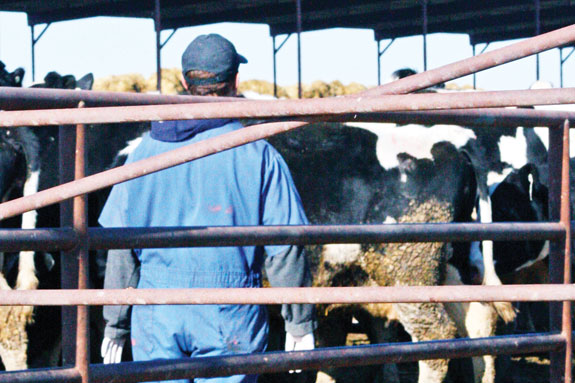Herd health morning ... cows are lined up and the vet is putting on a palpation sleeve. In your hand, a clipboard with the list of bred cows to check ... and off you go down the alley. “1520, 41 days ... ”
Seconds later, the vet’s response: “Pregnant.” Next, “1322, 35 days ... ” “Open ... ”
She is 90 days in milk and her last test day is staring at you from the clipboard: 150 pounds at this point; you are probably tempted to think that her high milk yield is the reason she’s not pregnant. ... Now, is that the whole story?
In this article, we dig deeper into the question, “What is the relationship between high milk production and reproductive performance of dairy cows?” There may be a lot more to this question than meets the eye.
New findings
Recent research from our group indicates that the association between milk production and fertility of dairy cows is more complex and multi-layered than anything we anticipated. Indeed, for a given high-producing cow that is found open, more than just her superior production seems to be involved.
Our group recently developed cutting-edge statistical methods to take a fresh, deeper look into the relationship between milk yield and fertility in dairy cows.
We applied these research methods to large DHIA datasets from several hundred farms, comprising over 120,000 cows calving during 2005 and 2006.
To make a long story short, our results provided solid evidence that it is an over-simplification to think that “one-size-fits-all” describes the relationship between milk yield and reproductive performance of dairy cows.
Instead, we found the production-reproduction relationship to be highly variable and differing with management practices and characteristics of the herd.
This is certainly good news, as it implies that it might be possible to enhance or fine-tune farm management to jointly optimize both milk yields and dairy cow reproduction.
In particular, highly specialized management practices that typically characterize intensive production systems, such as rBST supplementation and 3X milking frequency, were associated with a favorable link between milk yield and reproduction.
In other words, under intensive management, high milk yields did not necessarily match up with poor reproduction.
In some cases, the opposite was actually true and high milk yield went hand in hand with good reproductive performance. For example, among herds that used rBST extensively, calving intervals shortened by 1.3 days for approximately every 200-pound increase in herd 305-d milk yield.
Similarly, high-producing cows milked 3X were getting pregnant sooner than high-yielding cows milked twice daily.
Please note: We are not stating that rBST or increased milking frequency were the direct causes for enhanced reproductive performance of high-producing cows; nor should herds all be moving to more frequent milking and hoping to have rBST back on their shelves.
Instead, consider rBST and 3X milking as more general indicators of intensive farm management, noting that both practices imply more frequent opportunities for observing cows.
Thus, intensive management practices that encourage higher milk productivity also may facilitate better-than-average reproductive performance if the same level of management leads to more attentive and responsive observation of cows.
Further investigation certainly will be required to better describe these conditions; our group is already working on it.
Our new research approach
Given the age-old dogma that high milk yield inevitably results in poor reproduction, why would anyone believe our results? Our research methods were novel in that we deliberately accounted for cows and herds as separate units of performance that are interconnected with each other, as cows are managed within herds.
We can think of herds as production units, whereas cows managed within those herds may be considered physiological units of performance.
So the physiological (cow-level) relationship between milk production and reproductive performance within herds is not necessarily the same as the production unit (herd-level) relationship between average milk production and reproductive performance across herds.
For example, we found that there was generally a negative relationship between milk yield and reproduction within herds, whereas high-producing herds tended to have, on average, better reproductive performance.
Clearly, the delicate intricacies of a cow’s physiology were not mirroring the management mechanisms of the production system in which the cow was living.
Previous research had failed to make this cow vs. herd distinction. Such an omission may have resulted in a general assumption that does not necessarily apply to all cows in all herds.
Moreover, we should realize that we cannot just look at the connection between milk production and reproduction without accounting for other potential confounding factors such as genetics, nutrition, energy balance, body condition, presence of infectious diseases, metabolic diseases, and seasonal effects.
Our research statistical methods are more comprehensive than anything used in this field before. They were recently published in a leading biological statistics research journal.
These methods allow us to jointly evaluate milk production and reproduction while accounting for numerous other variables. This is a powerful new tool that provides a fresh perspective on the long-misunderstood issue of fertility of high-producing cows.
Conclusion
In summary, high milk yield does not mean that cows will definitely have poor reproductive performance. In fact, it is apparent that high-quality management upon which high production is based also can support good reproductive performance.
So, keep an open mind when it comes to reproductive expectations of your high-producing cows and give them the very best management and attention available ... your very best cows can really thrive both reproductively and in milk yield.
—Excerpts from Michigan Dairy Review, Vol 15, No. 4, pages 7 & 8.
PHOTO 1:Our research methods were novel in that we deliberately accounted for cows and herds as separate units of performance that are interconnected with each other, as cows are managed within herds. Photo by PD staff.
PHOTO 2:Intensive management practices that encourage higher milk productivity also may facilitate better-than-average reproductive performance if the same level of management leads to more attentive and responsive observation of cows. Photo by PD staff.





